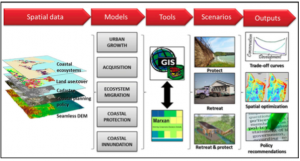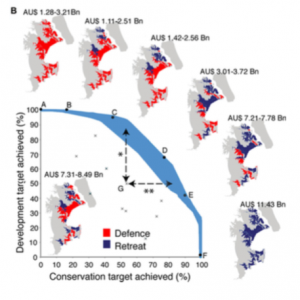Reconciling Development and Conservation under Coastal Squeeze from Rising Sea Level
By Timothy Hogan, SRC Intern
In the face of global warming, melting ice caps and thermal expansion gradually increase sea level, affecting the majority of the world’s coast. As a result, coastal ecosystems, such as mangrove forests and salt marshes, will lose a large amount of their diversity. The loss of settlements to flooding may also trigger massive migrations to inland cities (Nichols et al 2011), which can have many detrimental effects in and of itself. Preventative measures taken by coastal management should therefore prioritize both urban development and the shoreline’s ecosystem. Multiple views should be taken into consideration when determining adaptation strategies, since it involves a complex balance of socioeconomic pressures. However, for the sake of simplicity, most models focus on a specific set of aspect rather than the whole picture. As a consequence, these models tend to produce both conflicting and inconclusive results. This uncertainty, coupled with the innate short-sightedness of the human race, makes it becomes difficult for policymakers to create effective and scientifically supported regulations (Nicholls et al 2010).
Despite this lack of direction, environmentalists have developed many effective ways to counter sea level rise Two of these popular coastal management practices include coastal armoring and managed realignment. Coastal armoring involves the development of levees, which are effective walls of sediment, to stop water levels from spreading along the coast. While it is simple to implement and can be more cost-effective, it tends to cause “coastal squeeze”, which prevents the natural migration of marshes and mangroves (Pontee 2013). Should water level rise above the levee, the water tends to overflow and form more destructive floods, causing as much damage as what would have naturally occurred (ASFPM 2007). Managed realignment involves the manual movement of the shoreline, and is much less detrimental to nearby ecosystems (French 2006). However, this work tends to be a more expensive investment, and the withstandability and long-term impacts of the new shoreline remain unknown. Choosing between these methods effectively comes down to expenses, cost, long-term effects, and the nearby ecosystem. However, modern technology shows that the best solution may not be as simple as choosing one of these practices.
A recent study analyzed the effects of sea level rise on a coastal region in Queensland, Australia, due to its close proximity to a fast-growing city and coastal embayments. Data sets were compiled and analyzed to spatially quantify urban growth, land usage, ecosystem motion, coastal protection, and flooding. All information was combined using Marxan, a geographic information system that could spatially display and compare the gathered data. The developed map was divided into zones of equal area. Based on predicted sea level rise, urban growth, and environmental changes, the price of utilizing either coastal armoring, managed realignment, or both was calculated for each zone. An overall “trade-off” curve was produced by testing each possible scenario, and can be used to find the most optimal solution financially and conservationally.

Figure 1: A flowchart displaying the overall process behind the experimentation. Five sets of data (urban growth, land usage (acquisition), ecosystem migrations, coastal protections, and flooding (coastal inundation) were transformed into models, and combined using geographic information softwares. Testing scenarios allowed them to discern the most financially and environmentally viable solutions (Mills et al 2015).
According to the data analysis, 70% of both urban and conservation goals provides optimal benefits for both parties, while also saving billions of dollars. Any less provides fewer benefits and risks, whereas more tends to be detrimental and expensive. While this may seem counterintuitive, it makes sense given the effects of retreats. When established, the changed land and new funding will decreases the number of necessary ecosystem services, including fishing, carbon storage, and water purification. Hopefully, these insights may show institutions and committees the hidden savings behind ecological preservation, as well as protecting cities.

Figure 2: Visual representation of the land distribution and trade-off curve. Blue zones represent managed rearrangement, or “retreat”, and red zones represent coastal armoring, or “defence”. The blue curve on the graph shows likely scenarios based on global sea level rise estimations. The distribution of those was set along a trade-off curve, which showed the approximate price for utilizing each method. The price range for each displayed scenario is also shown for reference (Mills et al 2015).
While this study provided a new effective way to analyze benefits of coastal management practices, it still required the same simplicity. Vegetation, erosion, and the change of infrastructure over time were not sufficiently considered into the study, which causes predicted values to be lower than in reality. Corrections can be made with the assistance of experts in these fields. However, this new model manages to provides a new important element to non-scientists: direction. The trade-off curve is able to quantify various benefits of conservation and urbanization to find financially favorable solutions. This can act as guidance to policymakers, and may encourage them to focus on the long-term benefits of coastal lands and developments. While this may not necessarily solve the looming issues of sea level rise or address all of its repercussions, it gives vulnerable coastal civilization and environments a way to withstand the relentless rising sea.
References
Nicholls, R. J., and Cazenave, A. (2010). Sea-Level Rise and its Impact on Coastal Zones. Science, 328, 1517-1520.
Pontee, N. (2013). Defining Coastal Squeeze: A Discussion. Ocean & Coastal Management, 84, 204-207
Nicholls, R. J., Marinova, N., Lowe, J. A., Brown, S., Vellinga, P., de Gusmão, D., Hinkel, J., and Tol, R. S. J. (2011). Sea-level rise and its possible impacts given a ‘beyond 4°C world’ in the twenty-first century. Phil. Trans. R. Soc. A, 369, 161-181.
Mills, M., Leon, J.X., Saunders, M.I., Bell, J., Liu, Y., O’Mara, J., Lovelock, C.E., Mumby, P.J., Phinn, S., Possingham, H.P. and Tulloch, V.J. (2015). Reconciling Development and Conservation under Coastal Squeeze from Rising Sea Level. Conservation Letters.
ASPFM. (2007). Levees: the double-edged sword [online]. Association of State Floodplain Managers.
French, P.W. (2006). Managed realignment – The developing story of a comparatively new approach to soft engineering. Estuarine, Coastal, and Shelf Science, 67(3), 409-423.




Leave a Reply
Want to join the discussion?Feel free to contribute!